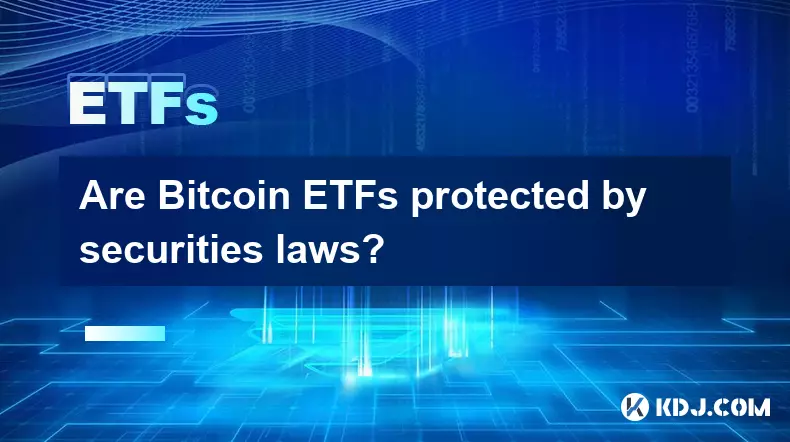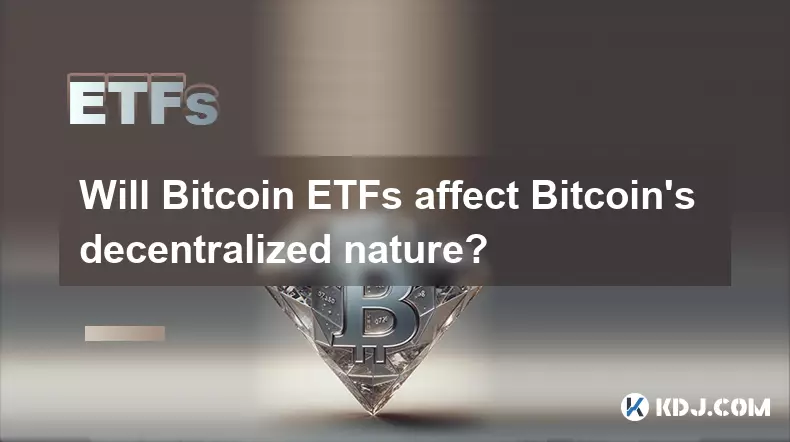-
 bitcoin
bitcoin $112195.049338 USD
2.42% -
 ethereum
ethereum $4124.915858 USD
2.81% -
 tether
tether $1.000570 USD
0.02% -
 xrp
xrp $2.861568 USD
2.25% -
 bnb
bnb $1000.346670 USD
3.04% -
 solana
solana $209.070819 USD
3.38% -
 usd-coin
usd-coin $0.999870 USD
0.02% -
 dogecoin
dogecoin $0.235379 USD
2.65% -
 tron
tron $0.335681 USD
-0.20% -
 cardano
cardano $0.803501 USD
3.38% -
 hyperliquid
hyperliquid $47.120881 USD
3.56% -
 chainlink
chainlink $21.501300 USD
3.44% -
 ethena-usde
ethena-usde $1.000571 USD
0.02% -
 avalanche
avalanche $29.793378 USD
3.62% -
 stellar
stellar $0.366964 USD
2.42%
Are Bitcoin ETFs protected by securities laws?
Bitcoin ETFs are regulated by the SEC, offering investor protections like custody oversight and disclosure, but don’t shield against market volatility or guarantee returns.
Sep 28, 2025 at 03:00 am

Regulatory Framework Surrounding Bitcoin ETFs
1. Bitcoin ETFs operate within the boundaries of established securities regulations, primarily under the oversight of the U.S. Securities and Exchange Commission (SEC). These funds are structured to comply with the Investment Company Act of 1940, which governs collective investment vehicles.
2. Before a Bitcoin ETF can be listed on a national exchange, it must file a registration statement under the Securities Act of 1933. This includes detailed disclosures about the fund’s structure, risks, management team, and custodial arrangements for the underlying Bitcoin assets.
3. The SEC evaluates each proposal based on investor protection, market manipulation risks, and the transparency of the underlying market. Approval is contingent upon demonstrating that the ETF’s listing agreement with a regulated exchange ensures surveillance-sharing and price integrity.
4. Once approved, Bitcoin ETFs are subject to ongoing reporting requirements, including quarterly Form N-PORT filings and annual audited financial statements. This level of disclosure aligns them with traditional equity and bond funds.
5. Regulatory scrutiny extends to marketing materials and advertisements. Fund sponsors must ensure all communications are accurate, avoid misleading claims, and clearly state the volatility and speculative nature of cryptocurrency investments.
Investor Protections Embedded in Bitcoin ETF Structures
1. Unlike direct ownership of Bitcoin, investing through an ETF provides a layer of institutional safeguards. Shares are held in brokerage accounts protected by the Securities Investor Protection Corporation (SIPC), covering up to $500,000 per customer for missing securities.
2. Custody of the underlying Bitcoin is managed by licensed third-party custodians who adhere to strict operational and cybersecurity standards. These entities are often regulated by banking or financial authorities and undergo regular audits.
3. The ETF structure introduces transparency through daily publication of the fund’s holdings via the net asset value (NAV). Investors can verify that the fund holds the claimed amount of Bitcoin, reducing counterparty risk.
4. Redemption mechanisms involving authorized participants help maintain price alignment between the ETF share and the spot price of Bitcoin, minimizing premium or discount deviations.
5. Anti-fraud provisions under the Securities Exchange Act of 1934 apply to Bitcoin ETFs. Misrepresentation or insider trading related to these funds falls under federal enforcement jurisdiction, enabling legal recourse for affected investors.
Risks Not Fully Mitigated by Securities Regulations
1. While securities laws provide structural protections, they do not shield investors from market volatility inherent in Bitcoin pricing. Sharp declines in the cryptocurrency market directly impact ETF share value.
2. Regulatory approval does not equate to endorsement of Bitcoin as an asset class. The SEC has repeatedly emphasized that its clearance of an ETF reflects compliance with listing standards, not validation of the underlying technology or long-term viability.
3. Differences in custody practices across issuers may expose investors to operational risks. Although most use insured cold storage solutions, variations in insurance coverage and audit frequency exist.
4. Secondary market trading of ETF shares introduces liquidity risks during periods of high volatility. Bid-ask spreads can widen significantly, especially during global macroeconomic shocks or regulatory announcements affecting crypto markets.
5. Tax treatment of Bitcoin ETFs differs from direct ownership. Gains may be classified as collectibles or subject to different capital gains rules depending on jurisdiction, complicating investor tax planning.
Frequently Asked Questions
Do Bitcoin ETFs guarantee the safety of my investment?No. While securities laws provide procedural safeguards, they do not protect against losses due to market fluctuations. The value of a Bitcoin ETF can drop sharply, and investors may lose part or all of their principal.
Are all Bitcoin ETFs regulated the same way globally?No. Regulatory approaches vary significantly. For example, Canadian Bitcoin ETFs were approved earlier than U.S. ones and operate under different frameworks set by provincial securities commissions like the Ontario Securities Commission.
Can the SEC shut down a Bitcoin ETF after approval?Yes. The SEC retains authority to initiate enforcement actions or suspend trading if an ETF violates disclosure rules, engages in fraudulent activity, or fails to maintain required compliance protocols.
How does investor recourse work if a Bitcoin ETF misrepresents its holdings?Investors may pursue legal action under Rule 10b-5 for material misstatements or omissions. Class-action lawsuits have been filed in similar cases involving traditional funds, and the same mechanisms apply to cryptocurrency-based ETFs.
Disclaimer:info@kdj.com
The information provided is not trading advice. kdj.com does not assume any responsibility for any investments made based on the information provided in this article. Cryptocurrencies are highly volatile and it is highly recommended that you invest with caution after thorough research!
If you believe that the content used on this website infringes your copyright, please contact us immediately (info@kdj.com) and we will delete it promptly.
- Solana: Institutions' Growing Confidence Signals a Bullish Future
- 2025-09-29 17:05:16
- PumpFun (PUMP) Price in October: Will the Memecoin Momentum Continue?
- 2025-09-29 16:25:14
- Cloud Mining, High-Yield Contracts, and Market Volatility: A New Yorker's Take
- 2025-09-29 17:05:16
- Royal Mint Error Coins: What's the Sell Price?
- 2025-09-29 16:25:14
- BABY Token Inflation and Co-Staking: A New Era for Babylon
- 2025-09-29 17:10:01
- Dogecoin, ETFs, and Memecoins: Navigating the Hype in the Wild World of Crypto
- 2025-09-29 17:10:01
Related knowledge

Will Bitcoin ETFs affect Bitcoin's decentralized nature?
Sep 24,2025 at 02:00am
Impact of Bitcoin ETFs on Market Accessibility1. Bitcoin ETFs have significantly lowered the barrier to entry for traditional investors who may not be...

Which exchanges list Bitcoin ETFs?
Sep 26,2025 at 03:18am
Major Cryptocurrency Exchanges Offering Bitcoin ETFs1. The landscape of digital asset trading has evolved significantly with the introduction of Bitco...

Are Bitcoin ETFs protected by securities laws?
Sep 28,2025 at 03:00am
Regulatory Framework Surrounding Bitcoin ETFs1. Bitcoin ETFs operate within the boundaries of established securities regulations, primarily under the ...

What role does a Bitcoin ETF play in an investment portfolio?
Sep 27,2025 at 12:36am
Understanding the Function of a Bitcoin ETF in Portfolio Diversification1. A Bitcoin ETF allows traditional investors to gain exposure to cryptocurren...

Is the volatility of Bitcoin ETFs consistent with Bitcoin?
Sep 26,2025 at 01:18am
Bitcoin ETFs and Their Relationship to Bitcoin Price Movements1. Bitcoin ETFs are financial instruments designed to mirror the price of Bitcoin withou...

Do Bitcoin ETFs support leveraged or inverse investing?
Sep 29,2025 at 03:18am
Understanding Bitcoin ETFs and Their Investment Structures1. Bitcoin ETFs, or exchange-traded funds, are investment vehicles that track the price of B...

Will Bitcoin ETFs affect Bitcoin's decentralized nature?
Sep 24,2025 at 02:00am
Impact of Bitcoin ETFs on Market Accessibility1. Bitcoin ETFs have significantly lowered the barrier to entry for traditional investors who may not be...

Which exchanges list Bitcoin ETFs?
Sep 26,2025 at 03:18am
Major Cryptocurrency Exchanges Offering Bitcoin ETFs1. The landscape of digital asset trading has evolved significantly with the introduction of Bitco...

Are Bitcoin ETFs protected by securities laws?
Sep 28,2025 at 03:00am
Regulatory Framework Surrounding Bitcoin ETFs1. Bitcoin ETFs operate within the boundaries of established securities regulations, primarily under the ...

What role does a Bitcoin ETF play in an investment portfolio?
Sep 27,2025 at 12:36am
Understanding the Function of a Bitcoin ETF in Portfolio Diversification1. A Bitcoin ETF allows traditional investors to gain exposure to cryptocurren...

Is the volatility of Bitcoin ETFs consistent with Bitcoin?
Sep 26,2025 at 01:18am
Bitcoin ETFs and Their Relationship to Bitcoin Price Movements1. Bitcoin ETFs are financial instruments designed to mirror the price of Bitcoin withou...

Do Bitcoin ETFs support leveraged or inverse investing?
Sep 29,2025 at 03:18am
Understanding Bitcoin ETFs and Their Investment Structures1. Bitcoin ETFs, or exchange-traded funds, are investment vehicles that track the price of B...
See all articles










































































